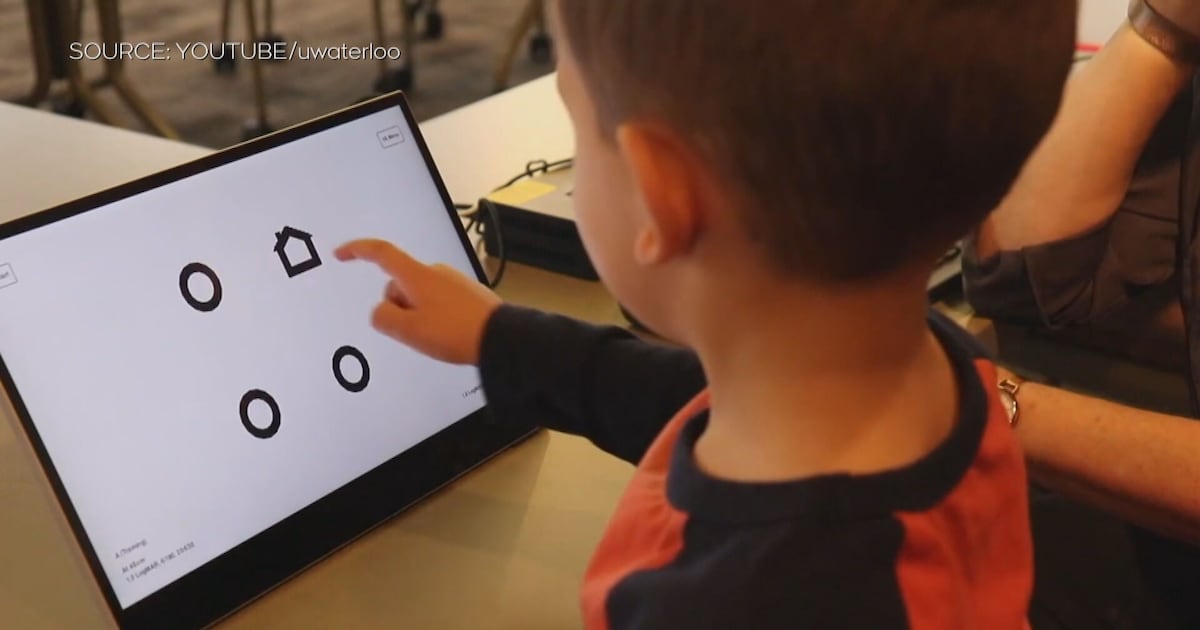Science
New Eye Test Revolutionizes Vision Screening for Toddlers

Diagnosing vision problems in very young children has traditionally been a significant challenge for eye care professionals. A groundbreaking tool developed at the University of Waterloo aims to change this. The new method, known as the Waterloo Differential Acuity Test (WatDAT), is designed specifically to measure eyesight in children as young as 18 months.
The test employs a straightforward concept: toddlers are shown four images—three identical and one different. They are then asked to identify the odd one out. This process is repeated with images that gradually decrease in size until the child can no longer distinguish the difference, effectively revealing their visual acuity in a manner that is engaging and age-appropriate.
Dr. Susan Leat, professor emeritus at the University of Waterloo, highlighted the importance of this innovation. “Measuring these types of vision problems is crucial because if they’re not detected or treated, it can affect the child’s learning and general development,” she stated in an interview with CTV News Kitchener.
Research indicates that approximately 14 percent of children within this age group suffer from undiagnosed vision issues, which may include conditions such as astigmatism, farsightedness, or amblyopia, commonly referred to as lazy eye. In rarer instances, children may experience serious conditions like pediatric cataracts, which can hinder the normal development of their sight.
Dr. Leat emphasized that these vision impairments often go unnoticed. “Children will not complain about poor vision because they don’t know what good vision is,” she explained. The WatDAT test aims to facilitate earlier detection of vision disorders, enabling more effective treatment.
Currently, the standard practice among optometrists involves eye movement tests for infants and toddlers. These tests track a child’s gaze as they look toward striped patterns. While useful, they can only determine whether a child can see a pattern, rather than whether they can accurately recognize or interpret details. For older children, who are typically shown pictures or letters, the testing methods often fail for toddlers who lack the vocabulary or attention span necessary for these tasks.
With WatDAT, the testing begins with larger shapes that gradually become smaller, similar to the letter tests adults are familiar with during eye examinations. “So this is equivalent to the letter test that an adult would be asked to read when they’re at the optometrist,” Dr. Leat noted. Because the method relies on visual matching rather than language skills, toddlers find it easier to complete successfully.
During initial testing, nearly all children aged 24 months and older who met developmental milestones successfully finished the test with both eyes. Remarkably, even children born prematurely or with other health challenges were often able to participate effectively.
Currently, optometrists in Canada, the United States, and the United Kingdom are beta-testing both printed and digital versions of the WatDAT system. The digital format adds an interactive element, rewarding children with cartoon animations, such as a dancing Winnie the Pooh, when they correctly identify the odd image. This gamified approach helps to make the testing process feel less clinical and more enjoyable for young children.
“WatDAT is kind of unique—there’s nothing like it,” Dr. Leat remarked. The playful nature of the test seems to resonate well with children, fostering a positive experience. As the testing phase nears completion, researchers are optimistic about commercializing the tool, making it available for eye care professionals globally.
“Once it’s on the market, it will be available for optometrists and ophthalmologists to purchase,” Dr. Leat confirmed. With this innovative approach, the hope is that early detection of vision disorders will lead to better outcomes for young children, ultimately supporting their growth and development.
-

 Education3 months ago
Education3 months agoBrandon University’s Failed $5 Million Project Sparks Oversight Review
-

 Science4 months ago
Science4 months agoMicrosoft Confirms U.S. Law Overrules Canadian Data Sovereignty
-

 Lifestyle3 months ago
Lifestyle3 months agoWinnipeg Celebrates Culinary Creativity During Le Burger Week 2025
-

 Health4 months ago
Health4 months agoMontreal’s Groupe Marcelle Leads Canadian Cosmetic Industry Growth
-

 Technology3 months ago
Technology3 months agoDragon Ball: Sparking! Zero Launching on Switch and Switch 2 This November
-

 Science4 months ago
Science4 months agoTech Innovator Amandipp Singh Transforms Hiring for Disabled
-

 Education3 months ago
Education3 months agoRed River College Launches New Programs to Address Industry Needs
-

 Technology4 months ago
Technology4 months agoGoogle Pixel 10 Pro Fold Specs Unveiled Ahead of Launch
-

 Business3 months ago
Business3 months agoRocket Lab Reports Strong Q2 2025 Revenue Growth and Future Plans
-

 Technology2 months ago
Technology2 months agoDiscord Faces Serious Security Breach Affecting Millions
-

 Education3 months ago
Education3 months agoAlberta Teachers’ Strike: Potential Impacts on Students and Families
-

 Science3 months ago
Science3 months agoChina’s Wukong Spacesuit Sets New Standard for AI in Space
-

 Education3 months ago
Education3 months agoNew SĆIȺNEW̱ SṮEȽIṮḴEȽ Elementary Opens in Langford for 2025/2026 Year
-

 Technology4 months ago
Technology4 months agoWorld of Warcraft Players Buzz Over 19-Quest Bee Challenge
-

 Business4 months ago
Business4 months agoNew Estimates Reveal ChatGPT-5 Energy Use Could Soar
-

 Business3 months ago
Business3 months agoDawson City Residents Rally Around Buy Canadian Movement
-

 Technology2 months ago
Technology2 months agoHuawei MatePad 12X Redefines Tablet Experience for Professionals
-

 Business3 months ago
Business3 months agoBNA Brewing to Open New Bowling Alley in Downtown Penticton
-

 Technology4 months ago
Technology4 months agoFuture Entertainment Launches DDoD with Gameplay Trailer Showcase
-

 Technology4 months ago
Technology4 months agoGlobal Launch of Ragnarok M: Classic Set for September 3, 2025
-

 Technology4 months ago
Technology4 months agoInnovative 140W GaN Travel Adapter Combines Power and Convenience
-

 Science4 months ago
Science4 months agoXi Labs Innovates with New AI Operating System Set for 2025 Launch
-

 Top Stories2 months ago
Top Stories2 months agoBlue Jays Shift José Berríos to Bullpen Ahead of Playoffs
-

 Technology4 months ago
Technology4 months agoNew IDR01 Smart Ring Offers Advanced Sports Tracking for $169










